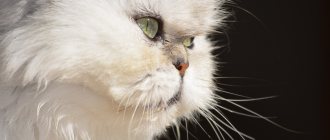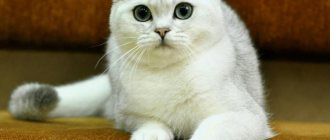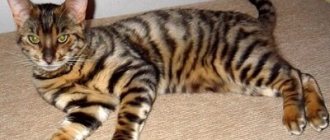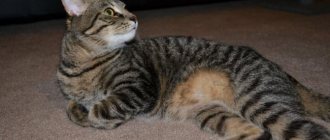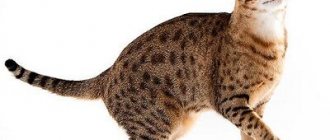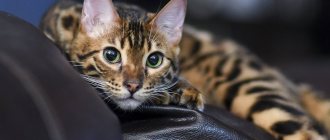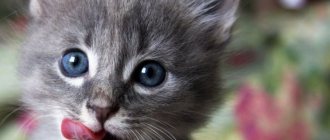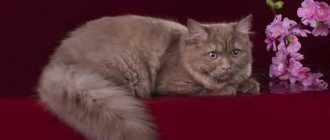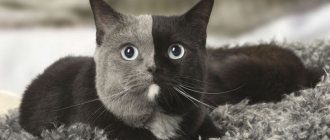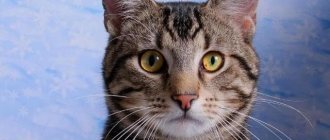The aristocrat of the cat world, which differs from its fellows with its magnificent iridescent hair - the chinchilla - enjoys universal love. Among her advantages are not only her appearance, but also her affectionate, discreet character. Due to its color, the chinchilla was registered as a separate species, but without being assigned a classification. Persians, British, and Scots have unusual wool.
Origin story
The chinchilla breed originates in Great Britain. It was there that the first Persian cat with an unusual color was born - Sheena. Breeders paid attention to the baby in 1882, which was the beginning of breeding work.
Sheena's owner chose a cat with a suitable color for her pet. From these matings two litters of silver kittens were born. They were exhibited quite successfully, but did not leave offspring (at least there is no data on this). The first officially registered chinchilla cat appeared as a result of crossing the Betty cat with a smoky male.
The selection continued. Due to the small number of individuals of this variety, the descendants of the first chinchilla began to be crossed with purebred British. To fix the bright green color of the eyes, tabby blood was added. At first, the kittens were born dark, they looked more like blue-gray British cats. Over time, breeders managed to achieve a pearly sheen.
Initially, this color was considered an advantage of exclusively long-haired cats with pronounced Persian roots. By the 1970s, this coat color began to be taken into account in British and some other cat breeds.
Experts are still arguing about whether chinchillas should be considered a separate breed or a subspecies of Persians. Be that as it may, this color was the first to be specially selected. He is assigned by breeders, but without qualifications.
Attitude to training
The Persian chinchilla is not aggressive and is easy to train. From the first days of her appearance in your home, it is important to give your new pet as much attention as possible, but not to bore him.
After a few days, when the kitten gets used to its new abode, show it a place for feeding, toileting and spending the night. Control will be needed only in the first week.
To make the task easier, try to play more with your pet during this period near its litter tray. If necessary, put the cat inside, and when he relieves himself, pet him.
It will be useful for you to learn how to choose a tray for your pet, filler, as well as how to quickly accustom a cat to a tray or toilet, and how to get rid of the smell of cat urine.
Basically, the silver and golden variety of Persians do not face toilet issues, but due to a stressful situation, you may be presented with a “gift” in a forbidden place. Such cases require persistence and patience from the owner.
Please note that increased attention contributes to the spoiledness and capriciousness of the ward. It is important to play more outdoor games with him and take care of the availability of special toys in a timely manner. Otherwise, the cat will become passive, and in such conditions he is at risk of obesity.
During the training process, you should take into account that Persian chinchillas are characterized by excessive touchiness, intelligence and resourcefulness. If you want to quickly win over your four-legged friend, never raise your voice at him. Be prepared for the fact that, having played too much, the animal will not feel that it has already scratched your hands until they bleed or bitten you painfully.
Important! In raising pets, the main role is played by the tone in which you give commands. Trained cats only need to hear their name to understand what needs to be done.
The most common commands for this type of cat are: “Fu”, “No” . Words can be replaced by clapping your hands.
In case of mistakes, it is important not to use physical force on your pet. Reward all correctly completed tasks with a piece of your favorite treat, and correct mistakes by repetition, but for this, be patient.
Experts believe that training cats needs to be systematic. And they call fright the best way of punishment: you can splash the naughty boy with water or throw a crumpled newspaper at him.
Description of the breed
Several breeds of cats can be classified as chinchillas, which is why there are discrepancies in standardization. There are general indicators that unite all varieties.
Standard
The CFA standard describes the chinchilla as a medium-sized cat that looks much larger due to its dense and thick coat. The average weight of a cat is from 5 to 7 kg. The cat is slightly smaller - from 3 to 5 kg.
A purebred chinchilla must meet the following characteristics:
- Body: compact with wide bones, straight back, short, powerful legs, with round pads, thick tail, proportional to the body.
- Head: round with a small chin, wide jaws, massive neck, wide, short, snub nose;
- Eyes: wide apart, large, bright, with dark edging. The color is green or gray-blue.
- Ears: small in size with rounded tips, set low and wide, tilted forward.
- Coat: thick, with a dense undercoat; tufts of fur can be seen between the toes. Long-haired and short-haired varieties of the breed are acceptable. The hair of these cats has a lighter shade at the roots and gradually darkens towards the tips.
The following color varieties are recognized:
- gold;
- silver;
- silver shaded.
Breed defects include:
- white spots (stars or medallions);
- tail creases;
- extra fingers, or lack thereof;
- strabismus;
- For the color point variety, white toes and any eye color other than blue are considered defective.
Health
The average life expectancy of chinchillas is from 12 to 15 years. Provided that the kitten does not have any hereditary diseases.
Chinchillas have good health and endurance. But, there are a number of diseases characteristic of this variety, which they inherited from their Persian and British ancestors.
Chinchillas are at risk for:
- hypertrophic cardiomyopathy;
- retinal atrophy;
- polycystic kidney disease.
Attention! Teeth are the weak point of these cats. At the slightest suspicion of caries development, you should contact your veterinarian!
A cat can be protected from the most dangerous acquired diseases by timely vaccination.
A kitten aged 6-8 weeks must be vaccinated against:
- rabies;
- plague;
- calcivirosis;
- rhinotracheitis.
Veterinarians use complex products that include strains of pathogens of all of the above infections. The cat is revaccinated at 12 months, then repeated annually.
Modern drugs are effective and well tolerated by animals. The main thing is to contact a certified veterinary clinic.
Character
Magnificent royal chinchillas are recognized aristocrats of the cat world. This is a common characteristic of all cats of this color. The bright breed representatives of chinchillas – Persians and British – differ somewhat in temperament.
The Persian chinchilla is more playful and curious compared to the native of Foggy Albion.
The British cat is radically different from its counterparts with a different color with an affectionate, calm character. They are very mannered and sophisticated. They will gladly accept the gentle stroking of the owner, but will not allow themselves to be squeezed or kneaded.
Attention! Chinchillas need to be played with. Lack of activity has a detrimental effect on your pet's health!
Common to all chinchillas are:
- high level of intellectual development;
- lack of aggressiveness;
- cleanliness;
- ability to quickly master the basics of training. It is quite easy to accustom such cats to the litter box and other rules of behavior in the apartment;
- intelligence.
Chinchillas have a neutral attitude towards children ; they do not feel negative towards young family members, but they will not indulge them in fun and rough games. The cat most likely will not make friends with other pets. This breed is very proud, does not tolerate competition and always strives to confirm its dominance.
Personality of Chinchilla Persian cats
These animals have a kind and playful disposition. They love the company of their owners, so if they are left unattended for a long time, they become apathetic and lethargic - they become sad. They are friends with children, but they do not tolerate cat competitors.
They require attention only to themselves and this must be taken into account. On the other hand, representatives of this breed become so attached to the owner that they follow him on his heels. Like real aristocrats, they do not like to wander and do not run away from home. They prefer a calm, measured lifestyle.
Photos of chinchillas
golden
silver
silver shaded
Persian
Breed card
| Characteristics of a cat | Notes | |
| General information | Aristocratic cats with a specially bred coat color. The selection involved British, Persian and Siamese breeds | The breed is registered as a separate variety, but has no classification |
| Character | British chinchillas are calm and lazy. Persians are more active and inquisitive | Likes to be the center of attention |
| Appearance | Dense, thick coat of pearl, silver or gold color, large green eyes, rounded head with cheeks and small ears | |
| Behavior at home | Chinchillas will not tolerate rough play or persistence from small children. Possible problems with living together with other pets | It is not recommended to leave a child under 6 years old alone with a cat for a long time. |
| Care | The thick fur of chinchillas requires special care. It is necessary to comb your pet at least 2-3 times a week (or better yet, daily) and bathe it once every 1-2 months. | Insufficient care will lead to the formation of tangles. Poor quality food can cause yellowing of the coat |
| Health problems | Genetic predisposition to heart disease and susceptibility to caries | British chinchillas do not tolerate anesthesia well |
Feeding
The animal's nutrition must be of high quality and balanced. Leading veterinarians recommend using commercially prepared food in the form of dry granules or pouches with wet food. The best option would be to use holistic or super-premium food. Since only high-quality feed guarantees the optimal content of macroelements and minerals in the composition.
If you want to feed your pet natural food, the best option would be to create a diet with the participation of a veterinary nutritionist. Adjusting your diet on your own is not a desirable practice when caring for your beloved pet. This can cause the development of problems with the digestive system or allergic phenomena. Feeding from the table, a minimum of protein in the diet, can cause huge problems in the future.
Important! Proper nutrition is the main pillar of health for an animal. High-quality feeding guarantees excellent coat condition, high activity and the absence of health problems.
Care
Chinchillas are unpretentious in maintenance, but require care to maintain their external splendor. Especially if you are going to shine with your pet at exhibitions.
Wool
The main difficulty in keeping a chinchilla is the cat's fur. Caring for it involves the following manipulations:
- brush your cat at least twice a week (preferably every day). Run a wide-toothed comb through the fur, then a fine-toothed comb to remove any loose hairs. After this, comb the animal with a brush with stiff bristles, first along the hairline, then against it;
- if tangles do form, they need to be carefully cut off;
- Don't forget to comb the areas between your toes. The chinchilla has a short tongue, so it is difficult for her to care for the skin;
- You need to bathe your cat regularly, using a special shampoo. Make sure that foam does not get into your eyes and ears. After washing, the animal should be dried with a hairdryer and wrapped in a warm towel.
Before the exhibition, a light chinchilla is washed 5-7 days in advance, and before the show it is sprinkled with talcum powder or special powder.
A dark-colored cat is rinsed with cherry laurel water, and the fur is “fluffed” on the eve of the event.
A properly selected diet plays a very important role in caring for a chinchilla.
Ears, eyes and claws
A chinchilla needs to be taught hygiene procedures from early childhood:
- the eyes of these cats tend to water, so they should be wiped every day with a soft cloth soaked in warm boiled water or a weak chamomile infusion;
- Inspect your ears regularly and clean them once a week with a cotton pad;
- claws should be trimmed once a month if your pet has a special “scratching post” from a pet store. If there is no such device, the procedure will have to be carried out once every two weeks.
- It is very important to teach the kitten to brush its teeth; this should be done 2-3 times a week, since chinchillas’ teeth are susceptible to caries. Dry food helps get rid of the formation of stones and plaque.
Nutrition
Owners of any cat have a choice: feed the animal with industrial food or natural food. If you decide to go with the first option, keep in mind that chinchillas are not very active, are quite large and prone to obesity. The food needs to be balanced, enriched with vitamins and microelements (especially calcium and biotin), but low in calories.
Do not choose food with a high content of vitamin A - this will cause the white coat to turn yellow. Premium and super-premium products are suitable for long-haired cats.
Never feed your animal food from the supermarket!
Recommended brands:
- Pro Plan;
- Eukanuba;
- Hills;
- Royal Canin.
Before the exhibition, to restore the strength of the torso, you can give kitten food with a high content of proteins and fats for several days.
Attention! You can’t suddenly change the brand of food - the chinchilla may have an allergic reaction in the form of ear itching!
If you decide to cook for your pet yourself, you need to include in your cat’s diet:
- boiled chicken without skin;
- beef;
- cottage cheese;
- rabbit meat;
- ground bones;
- eggs (no more than twice a week);
- offal;
- dairy products;
- boiled sea fish without bones and skin.
You should not give your cat:
- river fish;
- sausage;
- milk;
- smoked meats;
- fatty and fried foods from the table.
Due to the specific structure of the muzzle, chinchillas' food should not be hard. Meat and offal should be given cut into small pieces, after keeping them in the freezer for five days to prevent the cat from becoming infected with helminths.
It is better not to combine natural feeding of an adult animal with ready-made food. For example, to feed dry food in the morning and home-cooked food in the evening, it’s worth stopping at just one thing.
Walking your pet
The chinchilla doesn't need regular walking, but it won't hurt. If the cat lives in a private house, you can let it go for a walk in the yard, after first making sure that there are no objects dangerous to the animal.
A cat living in a city apartment must be taken outside on a harness. Don't forget to also wear a pest collar.
Health and life expectancy
The health of a cat of any breed is primarily the merit of competent breeding and proper care on the part of the owners.
Crossing individuals that are closely related, or in the presence of chronic diseases, can only in rare cases produce a healthy kitten. When purchasing an animal, you first need to make sure that the breeder is doing competent work - inquire about the availability of a license, the pedigree of the kittens, and collect reviews from former buyers.
Proper feeding, care, and carrying out a set of preventive treatments against infections and parasites are not the least important things in maintaining the health of an animal. Neglecting general recommendations can undermine the body of even the strongest cat.
Diseases
There are diseases that are unique to the feline chinchilla breed. Physiological characteristics and genetics are characteristics that can only be euthanized through prevention and proper care of the animal. Since chinchillas are descended from the Persian breed, they are characterized by pathologies that occur in Persians.
Discharge from the eyes of inflammatory origin is not uncommon for chinchilla Persians, requiring constant monitoring due to the specific structure of the muzzle
Since these animals have a narrow head shape and a flattened muzzle, they are characterized by deformations in the shape of the jaw. This can further lead to dental disease and problems with eating or drinking.
Small nostrils and soft palate often lead to breathing problems, which can result in possible problems with both the lungs and cardiovascular activity as a result of insufficient oxygenation of the blood.
Important! A flattened muzzle increases the likelihood of eye disease and tear duct problems.
Persian cats may genetically be carriers of a gene that leads to kidney failure - polycystic kidney disease. That is why breeders carry out intensive screening diagnostics to eradicate the problem of the breed.
How long do they live?
The lifespan of chinchilla Persians is inextricably linked to heredity and quality of life. Caring for and caring for a pet can prolong its existence for more than several decades. The average lifespan of chinchillas is 12-15 years.
How to choose a kitten
Before you become the owner of a chinchilla kitten, carefully weigh the pros and cons. If you decide that you can provide your baby with everything necessary, visit a cat show, get acquainted with the breeders, and only then go for a new family member.
Buy a kitten from a trusted nursery, or from people who value their reputation. You need to go to the house where he lives to pick up the baby. This will allow you to evaluate the conditions of detention and look at the parents.
The color of a chinchilla is very unstable; you can only get the desired silver or golden pet from two parents with the same coat color. It is recommended to take a small pet from its mother at 3 months. At this age it is already possible to evaluate its main characteristics.
Indicators of a healthy kitten:
- activity, curiosity;
- cool nose;
- clean, bright eyes;
- lack of discharge from the nose and mouth;
- anus without signs of inflammation;
- limbs are strong, powerful;
- the body is short and dense;
- ponytail without knots;
- The fur is thick and shiny.
Attention! A healthy kitten's tummy should be soft, even if it has just eaten. A tightly stuffed belly is a sign that your baby has worms!
The cost of a chinchilla ranges from 400 to 600 dollars, but for a kitten from champion parents they can ask for more. Buying a baby at a price below the lowest limit is not worth it. There is a possibility of getting a defective or diseased individual.
Make sure you have the necessary documents: a veterinary passport with vaccination marks and pedigree.
Why do felinologists and owners value the breed?
People are attracted by the noble white color of the animal's coat. It resembles the fur of an Angora cat. The animal's hair is famous for its tenderness and fluffiness.
The Persian chinchilla cat breed attracts attention with its expressive look. This is facilitated by the flattened muzzle and bright green tint of the eyes. It seems that the wool queen drew arrows on her eyelids. Other benefits of pets:
- the Persian chinchilla has ideal body proportions;
- the rounded muzzle gives the animal a good-natured appearance;
- long beautiful wool;
- a small nose is a characteristic of all Persians;
- impressive size (adult cats and female cats weigh from 4 to 7 kilograms).
The Persian chinchilla is a cat with a bushy tail. The hair on this part of the body is 20 mm longer than in other places. Therefore, the woolly king can use its tail as a fan.
Breeding
Breeding chinchillas in Russia is accompanied by certain difficulties. Due to the difficulties in caring for the coat and maintaining color, there are few specialized nurseries.
Britons of silver or golden color can participate in mating, but choosing a pair for your pet is quite difficult.
If a partner is found, prepare your cat (or cat) for mating. Check with your veterinarian to make sure both animals are healthy. Perform deworming procedure. These measures will minimize the risk of sick or non-standard offspring.
Colors
The classic Persian chinchilla has snow-white fur. But there is also a so-called veiled color: when the tips of the hairs are colored and give the coat a certain shade. There may be several of them:
- Black.
- Tortoiseshell (this color is found only in cats).
- Lilac.
- Silver.
- Yellow (or rich apricot).
- Chocolate.
- Striped.
- Smoky.
There are animals with golden tips - the Persian golden chinchilla, as well as the red cameo and cream cameo - the tips are colored cream and red, respectively.
The photo shows a cat of the Persian chinchilla breed. Classic white color, as well as silver and gold
Classic-colored cats have the most pigment in the ears, tail and paws. It has also been noted that the shorter the coat, the brighter the color. Golden chinchillas have a creamy, reddish or milky undercoat, and the hairs at the tips are brown. All together creates a feeling of shimmer on the wool.
Interesting Facts
Chinchillas gained modern popularity thanks to the British Princess Victoria. Fascinated by the color of the cat, she spread the fashion for the breed among the nobility of the royal court.
The exhibition at the National History Museum in London includes a stuffed chinchilla cat. This representative of the breed was the owner of a record number of awards and titles at cat shows.
Chinchillas are rightfully considered one of the most beautiful and unusual cats. They are sociable, friendly, do not spoil things, and love their owner very much. But, before purchasing such a beauty, you need to soberly assess your capabilities. These aristocratic creatures deserve full care and maintenance.
How did the Persian chinchilla come about?
The first Persian-chinchilla cat was born in England. This happened in 1882. Even the granddaughter and namesake of Queen Victoria had a similar pet. This variety of four-legged pets was called the silver lambkin. Now the stuffed animal of the first representative of the famous breed is kept in the Natural History Museum.
The ancestors of the breed, like those of other Persians, originated from Iran (Persia). Therefore, the Persian chinchilla cat breed fully complies with the standard of the classic Persian cat.
